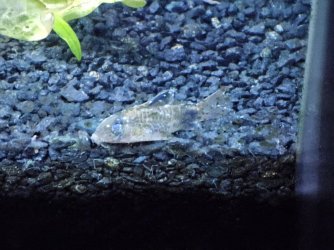I have been fortunate to have met Ian at CatCon some years back. I had enough time to shake his hand and to thank him for sharing all his cory knowledge with hobbyists. I have met and talked with Hans on several occasions and Ingo Seidel a few times as well. And last Oct. I met and talked with Leandro at CatCon. I consider Hans, Ingo and Leandro to be some of the most knowledgeable people in the world when it comes to the the plecos I keep and breed. These opportunities were all at weekend fish events where the above folks were either speakers or just attendees. I have been very lucky to meet, and usually talk with, people whose tanks I consider myself barely qualified to clean.
Ian is a member on Planetcatfish and there are a number of excellent threads and posts by him. I am pretty sure he and Jools communicate regularly. If any information on PC about corys were not accurate, I think Ian would have brought it to Jools' attention.
Here are two posts on PC by Ian the first is from 2011 and the second from 2009. So it is entirely possible he revised his thinking since then. I am not registered on his site. I am too cheap to be a paying member since I keep corys mostly for my enjoyment and not to spawn. I have spawned a few in years past and currently am working with some black schultzei. But I keep them at 24-25C (75-77F) with a target of 76F.
The first thread is titled
Hatching problems with C. gossei and Ian's post reports keeping his at 28C i.e. 82.4F.
https://www.planetcatfish.com/forum/viewtopic.php?f=6&t=32327&p=213836&hilit=gossei#p213836
The second thread is titled
85f cory? And he lists a few corys which can be kept in warmer water,
https://www.planetcatfish.com/forum/viewtopic.php?f=6&t=25368&p=149251&hilit=gossei#p149251
In the 2nd thread in another post by Frank, aka coyologist, notes that he keeps his sterbai with his discus at 86F. I bought my Budrovcan line L236 plecos from Eric B. Eric who wanted me to meet him at Frank's home in NJ. Eric was driving there to pick up Ian. The idea of being in the same room with three of the worlds most expert breeders of corys almost made me jump out of my chair. Unfortunately, Eric then explained that he and Ian would have to leave almost immediately as they had scheduled a meeting with somebody on their way back to Eric's home where Ian would be staying. Since I would not have the chance to pick up an amazing amount of cory info at Frank's, I arranged to meet Eric along the way there as it shortened my round trip time by 2 hours. *sigh*
I have not kept discus in many years now. When I did I had sterbai with mine for a while. But the longest term catfish co-habitants with the discus were a couple of zebra plecos which I had to park for a few years. The discus tank was the only one I had warm enough for the zebras.
As for treating Ich, there are actually strains which can live at 90F though most cannot. One reason I prefer using the meds is that they should work pretty fast especially in an elevated temp. Once done they can quickly be removed close to 100% by doing a water change and then adding carbon to ones filter. Salt can only be removed by water changes. So plants and fish which are less tolerant of salt may not fare so well.
The downside to using meds is that some fish do not handle them well, even for a short duration.
You would not believe how many things have been tried to defeat Ich. A Review Article on he subject:
Picon-Camacho, S.M., Marcos-Lopez, M., Bron, J.E. and Shinn, A.P., 2012. An assessment of the use of drug and non-drug interventions in the treatment of Ichthyophthirius multifiliis Fouquet, 1876, a protozoan parasite of freshwater fish.
Parasitology,
139(2), pp.149-190.
(Received 17 June 2011; revised 12 September 2011; accepted 16 September 2011; first published online 14 November 2011 by Cambridge University Press)
S U MM A RY
Infection by the ciliate protozoan Ichthyophthirius multifiliis Fouquet, 1876 causes significant economic losses in freshwater
aquaculture worldwide. Following the ban on the use of malachite green for treating food fish, there has been extensive
research aimed at identifying suitable replacements. In this paper we critically assess drug and non-drug interventions,
which have been tested for use or have been employed against this parasite and evaluate possibilities for their application in
farm systems. Current treatments include the administration of formaldehyde, sodium chloride (salt), copper sulphate and
potassium permanganate. However, purportedly more environmentally friendly drugs such as humic acid, potassium
ferrate (VI), bronopol and the peracetic acid-based products have recently been tested and represent promising alternatives.
Further investigation, is required to optimize the treatments and to establish precise protocols in order to minimize the
quantity of drug employed whilst ensuring the most efficacious performance. At the same time, there needs to be a greater
emphasis placed on the non-drug aspects of management strategies, including the use of non-chemical interventions
focusing on the removal of free-swimming stages and tomocysts of I. multifiliis from farm culture systems. Use of such
strategies provides the hope of more environmentally friendly alternatives for the control of I. multifiliis infections.
Full paper -->
http /dspace.stir.ac.uk/bitstream/1893/10147/1/Picon Camacho et al Parasitology Ich chemo review.pdf
/dspace.stir.ac.uk/bitstream/1893/10147/1/Picon Camacho et al Parasitology Ich chemo review.pdf


 /dspace.stir.ac.uk/bitstream/1893/10147/1/Picon Camacho et al Parasitology Ich chemo review.pdf
/dspace.stir.ac.uk/bitstream/1893/10147/1/Picon Camacho et al Parasitology Ich chemo review.pdf